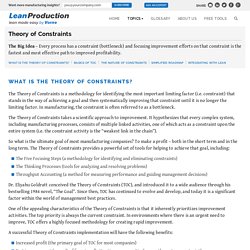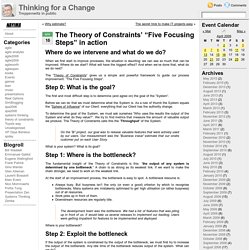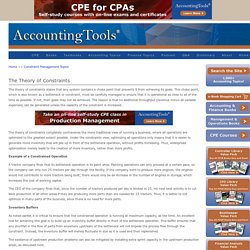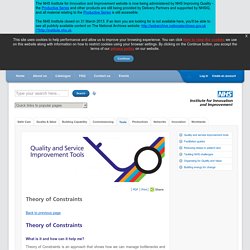

Focus Improvement on the Manufacturing Constraint. Core Concept The core concept of the Theory of Constraints is that every process has a single constraint and that total process throughput can only be improved when the constraint is improved.

A very important corollary to this is that spending time optimizing non-constraints will not provide significant benefits; only improvements to the constraint will further the goal (achieving more profit). Thus, TOC seeks to provide precise and sustained focus on improving the current constraint until it no longer limits throughput, at which point the focus moves to the next constraint.
The underlying power of TOC flows from its ability to generate a tremendously strong focus towards a single goal (profit) and to removing the principal impediment (the constraint) to achieving more of that goal. In fact, Goldratt considers focus to be the essence of TOC. The Five Focusing Steps The Five Focusing Steps are further described in the following table. What Is The Theory Of Constraints And How It Can Change Your Life. Theory of constraints (TOC) - explained. What is theory of constraints (TOC)? definition and meaning. Applying Theory of Constraints to Manage Bottlenecks. The theory of constraints is an important tool for improving process flows.

The implications of the theory are far reaching in terms of understanding bottlenecks to a process and better managing these bottlenecks to create an efficient process flow. The theory of constraints is an important tool for operations managers to manage bottlenecks and improve process flows. Made famous by Eliyahu M. Goldratt in his book The Goal, the implications of the theory are far reaching in terms of understanding bottlenecks to a process and better managing these bottlenecks to create an efficient process flow.
What is the Theory of Constraints, and How Does it Compare to Lean Thinking? What is the Theory of Constraints, and How Does it Compare to Lean Thinking?

The following article reviews the Theory of Constraints (TOC), first published in The Goal by Eliyahu M. Goldratt and Jeff Cox in 1984, and compares it with Lean Thinking, as described by James P. Womack and Daniel T. Jones in Lean Thinking in 1996. Theory of constraints (toc management systems fundamentals. Theory of Constraints (TOC) - Strategy Tools from MindTools.com. The Theory of Constraints’ “Five Focusing Steps” in action « Thinking for a Change. Where do we intervene and what do we do?

When we first start to improve processes, the situation is daunting: we can see so much that can be improved. Where do we start? What will have the biggest effect? And when we’ve done that, what do we do next? The Theory of Constraints. Home >> Constraint Management Topics The theory of constraints states that any system contains a choke point that prevents it from achieving its goals.

This choke point, which is also known as a bottleneck or constraint, must be carefully managed to ensure that it is operational as close to all of the time as possible. If not, then goals may not be achieved. Theory of Constraints. Back to previous page What is it and how can it help me?

Theory of Constraints is an approach that shows how we can manage bottlenecks and their associated constraints. A bottleneck determines the pace at which the whole process can work, whilst the constraint is the bit of kit or resource that causes the bottleneck. For more information on bottlenecks see 'A comprehensive guide to demand and capacity'. Take, for example, a simplified version of a typical patient pathway outlined below. GP referral 80 - Outpatient visit 75 - Surgery 12 - Follow Up 50 - Discharge 100 In this example, the bottleneck, or rate limiting step, is surgery. In complex systems like healthcare, there is always going to be a rate limiting step along pathways. When does it work best? There is national information on known ‘hot spots'. Diagnostic capacity for some diagnostic tests Theatre capacity It is important to make sure that you identify the real constraint.
How to use it 1. Look carefully for the true constraint. Theory of Constraints. Dr.

Eli Goldratt started the theory of constraints (TOC). He based this management theory that every system has at least one constraint limiting it from getting more of what it strives for.